Transcript
Jon Hazelwood: From International Design firm Hassell, you are listening to Hassell Talks. I’m Jon Hazelwood, I’m a landscape architect, a writer and a gardener. I’m joined by Su Lim from experience design firm Free State.
Su Lim: Hi Jon.
Jon Hazelwood: Welcome. We’re here in Naarm Melbourne on the lands of the Wurundjeri, Woiwurrung people of the Kulin Nation. I want to pay my respects to the elders past and present and acknowledge Aboriginal and Torres Strait Islander people as traditional custodians of the land where we live, work, and learn.
This episode we’re talking about spontaneity, and specifically spontaneity in our cities, why it’s a powerful force for bringing people together and how we design for it. Su, in your work, I guess you’re in the business of creating experiences. You design for many things, for the joy of collaboration, for movement. I imagine you’ve a really good sense of spontaneous experiences, the ones you stumble across. What do you think spontaneity is? What does it mean in our cities?
Su Lim: Yeah, it’s an interesting question, Jon. I think cities should be made with and for its residents. So in some ways it’s about handing over the reins to the community and not being too planned about things. So when I think of spontaneity in cities. It’s about allowing for the organic or unexpected or allowing for opportunities that might arise for a wide range of activities. It’s flexible. There’s space for change in order to be sustainable and relevant.
Jon Hazelwood: I guess we’ll come to the crux of the inherent conflict around planning of cities. The word “planning” of a city or the curation of cities, I guess inherit in that sentence is it’s not spontaneous. So how we go through that curation or that planning of cities and yet still allow spontaneity to occur on our streets, that feels to be the kind of crux of the issue.
Su Lim: Yeah. I mean, at Free State, we think about the term “over enabling” or over facilitating. I think that’s what we need to do rather than over curating, if you like. So perhaps one example of that is if you think about the development at King’s Cross, which is a wonderful example of a city regeneration.
Jon Hazelwood:
King’s Cross in London.
Su Lim: That’s right. King’s Cross in London. When they planned it, a third of the site was actually unresolved. So whilst it was planned, it was also planned to have change built into it. That actually allowed for Central St. Martins to come into the site, which wasn’t originally planned. So this idea that you can leave space for new things to emerge I think is really important when we think about city planning.
Jon Hazelwood: Because from my understanding, some of those temporary activation pieces that were enabled at Kings Cross, such as the freshwater swimming, et cetera, and those things they’ve actually changed how the development has been planned since then and the spontaneity of how they used those devices.
Su Lim: Yeah, absolutely. I think it’s this idea that you can quickly prototype new things all of the time. I think cities that are curated push out the opportunity for those sorts of things, which can really make places really rich.
Jon Hazelwood: As part of my work as you know, Su, I’m interested in how the non-human respond to the city as well, that spontaneity of an insect and through bringing in biodiversity into cities, but also the effect of that on how it encourages people to respond to nature as well as the city. It’s one of the few pieces of practise as a landscape architect where there’s demonstrative evidence on what it does to your heart rate and what it does to how you move through a city. You just look at the cherry blossoms in Japan and the activation that comes through that is something that I am interested in that those natural elements of the city aren’t in stasis, that they’re constantly changing, and they’re also spontaneous. So there’s as much joy in seeing a bird land on a tree as there is bumping into a friend on a street corner.
Su Lim: Yeah, I totally love that. I mean, sometimes we want those kind of efficient, seamless journeys where we want to get somewhere fast, but actually I think increasingly we need to balance those kinds of journeys with the open-ended meandering. I mean, that’s really essential for creativity and thinking. I think even during COVID, that was something that people really appreciated, that connection to their local communities, but the connection to nature was such a strong thing. I think people have sort of reconnected with that again, even in this post-pandemic world where I think people are realising that they need more green space, they need places in which to gather in nature. I mean, I love the idea that we need to design cities not just for people, but for ants and birds and everybody.
Jon Hazelwood: One of the key projects we’re working at the moment, the Melbourne Arts Precinct is a great example of that. There is healthy debates within the design teams and the stakeholders very much to what you were talking about, whether is it a space to go from A to B as quick as you can, from one cultural facility to another cultural facility, or is it that space for meandering and slowing down and smelling the flowers, I think is the cliché.
The other piece, I guess moving away from nature and back to I guess in how humans interact with the city, going back to the Great Jane Jacobs in the US and her writings. From her book in ’61, she wrote that the trust of a city street is formed over time from many, many little sidewalk contacts. It grows out of people stopping by a bar for a beer, getting advice from the grosser, or giving advice to the news stand man comparing opinions with other customers at the bakery and nodding hello to the two boys drinking pop on the stoop. Most of it is ostensibly utterly trivial, but the sum of it all is not trivial at all. That seems to be a kind of sum pf the conversation we’re having, I felt. Yeah,
Su Lim: That’s really wonderful. I’ve been reading a bit of James Gibson lately who talks about the concept of affordances. I think that might be relevant here too, the idea that a single physical intervention can create lots of different opportunities that are created by a single setting. So the idea that you can take something and make it your own and what might have been designed for a single use might actually have enormous diversity and freedom for change with the different sorts of audiences.
Jon Hazelwood: Su, I understand you were part of the MPavilion Event in Melbourne, looking at the role of data and design. Is that correct?
Su Lim: Yeah, absolutely. We had Hannah Fox from Rising, which is a festival in Melbourne, and it’s all across the city. Hannah shared a great example of a spontaneous experience during lockdown and how the absence of spontaneity really brought the idea of it into sharper focus.
Hannah Fox:
I think the loss of spontaneity during the Pandemic was one of the things I missed the most, just that ability to not know what your day or night or week was necessarily going to entail. One of the best things that happened to me in the last two years actually was walking along this river. I noticed Deborah Cheatham, who’s an incredible artist and opera singer, in a boat on the river. She was doing a listening trip to for some research, for a project that she was doing for Rising. I just flagged her down, and we got in the boat and went on this little listening trip together and it sparked a whole lot of ideas that became the foundation for the next programme. But that was something that just most people weren’t able to access I guess in the last two years that just happening upon a person that you admire or a piece of work that you admire and being inspired by it.
Su Lim: What Hannah’s talking about there is we are missing that surprise and delight. When we don’t have that, we don’t have anything to come together around. Actually there’s this great story which happened at the Tan Hill Inn in North Yorkshire where guests were all snowed in together, and they were trapped for several nights. Of course it was this terrible affair, and all of the travel plans were interrupted and all that sort of stuff. But because they couldn’t go anywhere, the pub started putting on quizzes and games and karaōke.
So all of these people, I think they were about 60 odd, were basically forced to hang out together for three days. So of course they made the most of it. What happened was they really came as strangers to this inn, but they left as friends. Now there’s talk of annual reunions. So you can see how this notion of serendipity, something that wasn’t anticipated, starts to turn into a whole new kind of community getting together. I think through lockdown, we didn’t have those kinds of opportunities for those kinds of surprising occasions.
Jon Hazelwood: I guess the flip to that through the experience over the past two years is the amount of anecdotal evidence that has been around the attraction to the open spaces of our cities as well. So if you take again, harking back to the work of Jane Jacobs that she obviously made the comment that people like to observe people, there’s a passiveness to spontaneity as well. There is the physical bringing together of people, and those moments that Hannah talked about. But there’s also the passive side of that was missing, the ability to observe people going about daily business. That there’s something, just sat in a park. Then the flip side of that obviously was there was actually from a non-humans perspective, more spontaneity happening as well because there’s tales of goats appearing in city centres in the UK and those sort of things.
That observation of people brings me to … I thought it’s worth touching on a city such as Shanghai, it’s a city as Hassell we work in. One my great regrets of the pandemic is not being able to visit our friends over in Shanghai. It’s a city I’ve enjoyed spending time on it, and I don’t think there is anywhere else I’ve experienced spontaneity in public spaces in the way it happens in Shanghai. We did some amazing research over there where our staff went into parks and open space and spoke to the users of the space and asked what it was that they enjoyed. So much of it was about observation, that kind of passive spontaneity.
There was a wonderful quote from Mr. Xi Zhong who was a user of one of the parks in Shanghai. His quote was, “At home, my wife complains about this and that about me, but when we’re in the park, there’s so many things to see, she doesn’t nag of me anymore.” That was his experience with spontaneity. I was wondering if you could speak about your observations of Shanghai and life in there, in that amazing metropolis.
Su Lim: Yeah. Well, it’s such a city of diverse contrast, isn’t it? You’ve got the old and new, the very traditional as well as that crazy futuristic blend of east and west, and it’s kind of open 24 hours. So you’re right. There’s always something to see, something happening or going on that is really kind of contrasting with perhaps what you’ve just been through. So yeah. I agree with you. I think it’s a wonderful place for people watching and discovering new things.
Jon Hazelwood: I think it’s amazing as we see as city, it’s just beginning to emerge from lockdowns now for Hassell, with our studio there. We’ve been really excited to watch our colleagues being able to experience the city again. We actually asked our colleague, Urban Designer Chong Wang about the presence of spontaneity in the daily life of Shanghai.
Chong Wang:
What I really love about living in Shanghai is that you don’t need to plan for your days or weekends. You just bump into different people and activity when you move through the city. I’ve got drawn into playing Diablo for hours, from wandering at the waterfront or just their pop-up events always happening around the city like clowning, parades, dancing, kids roller skating. Being in a big city like Shanghai, I think what is attracting us to stay was that stimulation. You could just go onto the street, you can go into the city and then things are happening.
The excitement and then the encounter to different things and to some unexpected events and moments, and people are so important to keep the level of creativity. Because as I say, it’s so inviting and it doesn’t need much effort to be part of. Then that encourage us contributing and participating and to be part of the events itself and to be part of the place and to be part of the presence. Yeah, I think that there’s a beauty to it. That’s been missed during the lockdown stage that we would like to be onto the street to go into the parks to again participate.
Jon Hazelwood: I love Chong’s point there about being the ability to go back into the streets in the park. I mean, I cannot imagine how those parks and those spaces were during the lockdown. I know my favourite activity in the time I spend in Shanghai is getting up early in the morning and heading out and just sitting on a park bench and watching huge crowds of people dancing or exercise. It’s a way of using a park spontaneously that just doesn’t happen here in our Australian parks, I don’t feel, and the same in the UK. It’s quite unique.
Su Lim: Yeah. I think there is that need to create opportunities for those things to happen. It’s designing our cities so that they allow for activities and activations to occur, that the place is always programmable so that people can take it over and take it on with whatever they want to do with it.
Jon Hazelwood: Where do you see the hand of the designer in something, in those kind of experiences we’re talking about? Obviously spontaneity is a powerful thing and as I mentioned at the beginning, there’s the conflict between allowing it to happen and the curation of it to happen. I guess as designers we don’t feel it can be left up to chance.
Su Lim: Yeah. I think we need to create opportunities for what we talk about as being collision, and that isn’t necessarily in the violent sense, but something that allows for a talking point, allows for specific attraction between people or perhaps between people and nature, places in which interest can arise I suppose. I think when we think about levels of efficiency, we often think to design out friction in our cities, but actually we need that chance of error. We need the ingredients of adventure. I think those things are important to consider as we are designing.
Jon Hazelwood: At risk of banging on about COVID, and I don’t want to keep on dwelling on COVID but it has been an extraordinary time. As we’ve talked about it is intrinsically linked to spontaneity within our cities. But a key part of this and what we’re interested in as an immediate change is how we bring this idea of togetherness within our cities. I mean, you can see already with festivals such as rising in Melbourne or Vivid in Sydney, in Australia. The mad rush of everybody desperate to attend and experience these. In Europe, it’s the mad rush to holiday, heading back to the Mediterranean. That’s great in terms of that’s related to spontaneity around activation and curation and city planning. So I was interested around how more permanent institutions, galleries, or even retail could be what value they can bring in terms of bringing spontaneity into our cities.
Su Lim: So one is kind of the concept of hyper burgers. So developed by a woman called Francesca Tembussi, which is actually kind of an inconvenient store. So it’s riles against the speed and efficiency of Amazon Go, which of course is touchless, so I don’t need to talk to anyone. Hyper Burgers is a store that’s designed to serve communities, not the business if you like. It’s a supermarket entirely run by the consumers. So there’s no middle man, people pay each other directly, but to participate they have to give something back. So they either have to bring food or donate their time or maybe packaging.
So through this kind of network, it becomes a community resource as opposed to a commercial business. So that’s one example. A second, which is also to do with the supermarket is the Dutch supermarket chain, Jumbo has these dedicated chat lanes for people who actually want to chat to the cashier. It’s part of this programme to reduce loneliness in communities. So if you actually want to go to the supermarket and you haven’t spoken to anyone, and you want to have a good old chat, you line up in a chat lane and everybody realises that there’s no speed going on there. It’s a slow lane for conversation whilst you’re buying your groceries. I think these are things that really speak to what people need as opposed to what businesses need.
Jon Hazelwood: At Hassell, we’re currently thinking about togetherness, togetherness in our cities. What’s the outcome of that? Because obviously there’s the designed outcome, there’s the hardware that’s involved in it, but what actually happens? What is the outcome from that word “togetherness” in the city?
Su Lim: When people come together, we can create great adventures and then in turn, that manifests in memory. I think as we know, memory is a really powerful thing. It’s the thing that creates that sense of belonging. It’s the thing that wants you to return and wants you to experience that time and time again. I think when that starts to happen, then we can almost move outside ourselves. We can learn something new. We can be exposed to different ideas and different people. In turn, at the most aspirational, perhaps it’s transformation.
Jon Hazelwood: I think yeah, that idea of that the outcome of togetherness is memories. I don’t think I can beat that, Su, I think you’ve summed it up. Thanks, Su, for the conversation. I think it’s not something we talk enough about when we’re sat down in our day-to-day jobs of designing how our cities are evolving. I know it’s something, obviously it’s close to Free State’s heart in the way you work and design, but the potential for change through spontaneity at the moment, it’s immeasurable. People talk about that changing of moments, those instances of enlightenment, when understanding is deepened, and our perspectives are changed.
You said it right at the very end there about it’s all about memories and that chance, a moment to connect people in new ways to the past and the future, but also the present as well. I think that that’s so important. So thank you for the conversation. Also, thanks to Hannah Fox and the M Pavilion team for the use of Hannah’s clip about spontaneity and to my colleague Chong Wang in Shanghai, Su Lim from Free State, of course.
Free State, have a terrific podcast series, you should be checking out called Free Thinking: Meeting the people leading the charge on resetting our cities all around the world. Again, of course, thank you to you, our listeners. This episode was produced by Pru Vincent, Verity Magdaleno and Jo Richardson. Thank you.








